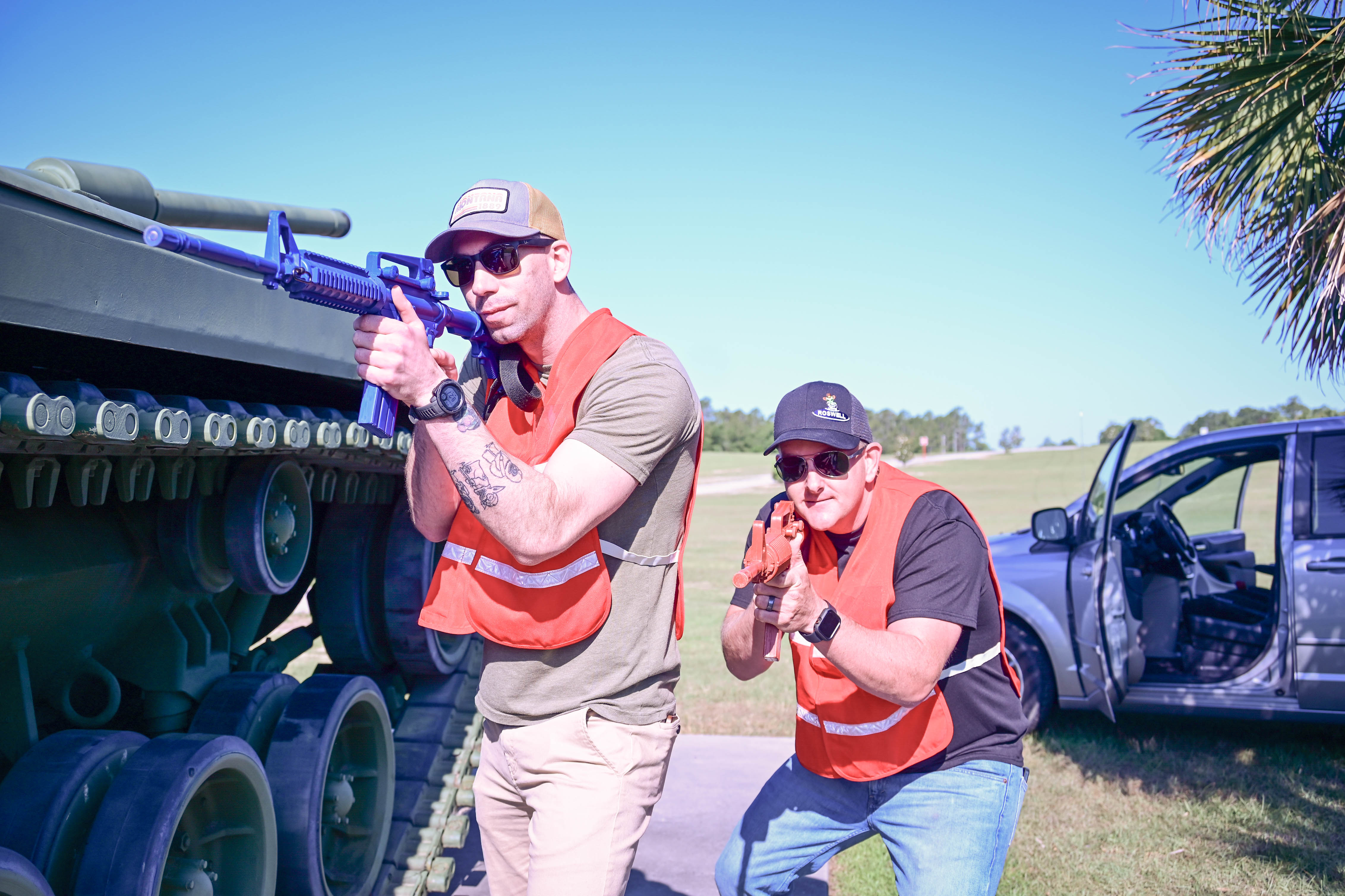
Sgt. 1st Class Adrian Doll, left, and Staff Sgt. John Smith, right, bath assigned to the Expert Soldier Badge Testing Management Office, Leader Training Brigade, hold assault rifle replicas as the proceed to Fort Jackson’s Hilton Field May 18, 2022, during the annual Full-Scale Exercise. The exercise tests the capabilities of the installation’s directorates to respond to an incident such as an active shooter. (Photo Credit: Alexandra Shea
Exercise prepares post for ‘event we never want to have happen’
By Alexandra Shea, Fort Jackson Public Affairs
Shots rang out across Fort Jackson’s Hilton Field on May 18 as more than 30 role players wearing simulated injuries ran onto the field screaming as five men ran through them carrying blue and orange plastic assault rifles.
The May 18 scene was chaotic and marked the start to the annual post-wide full-scale exercise. The annual exercise is designed to test and stress post directorates’ responses during a crisis such as an active shooter incident where responders control the scene, apprehend the shooters and save as many lives as possible.
“Think, what are the worst possible things that can happen to the Fort Jackson and Midlands community? The purpose of drilling our reactions to those critical events allows us to anticipate possible challenges we may not have recognized before,” said Brig. Gen. Patrick R. Michaelis, post commanding general. “That’s what’s happening here today.”
As the scene continued to unfold at Hilton Field, hundreds of Family members who crowded the field moments earlier to see their Soldier during Family Day got an up-close look at the battlefield capabilities Soldiers possess both home and away during deployments.
“This is crazy,” one parent said out loud. “I’m glad that’s not real,” said another.
As Directorate of Emergency Services police subdued three of the active shooters, two fled the field. After securing the scene, wounded Soldiers began providing basic first aid to those closest to them as ambulances and emergency medical technicians began triaging the simulated casualties, identifying the most to least wounded.
“What about Tom,” shouted Staff Sgt. Calvin Waynne, a drill sergeant assigned to 3rd Brigade, 60th Infantry Battalion, to the medics attempting to treat him. “You have to help me friend.”
Waynne suffered from a simulated head injury that included confusion and loss of hearing. Medics had to restrain him to prevent him from wandering away and making his wounds worse.
As medics continued to triage, treat and transport wounded from Hilton Field, the two remaining active shooters were reported to have infiltrated the Strom Thurmond building taking possible hostages and leaving backpacks with exposed wires hanging out of them near the main entrance and in a stairwell.
Installation police, military police and members of the Richland County Deputy Sheriff's Special Response Team had the building surrounded. Within an hour of arrival, the combined teams had the building secured and remaining shooters apprehended.
“This exercise benefits both elements because we get to come out here (to train) and see something different,” said James Abaham, tactical commander for the Richland County Sheriff’s Department. “We are equipped with a lot of tools for state of the art exercises and real world events.”
Abaham’s team deployed a miniature x-ray machine to see inside the bags left behind by the active shooter role players as well as a robot to help move and open the bags to identify any explosives that could be hiding inside.
“This bag is clear,” declared Drake Cobia, a bomb squad technician assigned to the Richland County Deputy Sherriff’s Special Response Team.
After the building was declared clear, Michaelis rounded out the final exercise events with a press conference with simulated local media outlets and a Commander’s Update Brief at the Emergency Operations Center to identify and discuss notes taken throughout the exercise by a team of Observer, Controller and Trainers brought to the installation.
“The outside observers give us an objective look. I think there is going to be organizational learning not just at Fort Jackson but across the Army with what we are doing here today,” Michaelis said. “There is a saying, ‘a gallon of sweat in training prevents an ounce of blood in war.’ This is about exercising systems in relation to an event we never want to happen but if it does happen, we know what to do and are prepared.”







